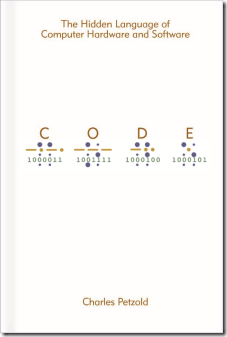Is Charles Petzold a guilty pleasure for you?
 Charles Petzold was mentioned yesterday in a New York Times Magazine article, “Stuff We Like That Maybe You Won’t.” Someone on the staff and contributing to the article said,
Charles Petzold was mentioned yesterday in a New York Times Magazine article, “Stuff We Like That Maybe You Won’t.” Someone on the staff and contributing to the article said,
My friends are (mostly) not interested in the history of electrical engineering, which is the subject of Charles Petzold’s “Code.” I find it gripping!
We’re pretty sure many of you find the book gripping, too. Tell us about it. Is it a guilty pleasure? A thriller, as Charles builds his explanations, switch by switch, diagram by diagram? A book you give to friends and never get back?
If you’re unfamiliar with Charles’s classic, here’s a description:
What do flashlights, the British invasion, black cats, and seesaws have to do with computers? In CODE: The Hidden Language of Computer Hardware and Software, they show us the ingenious ways we manipulate language and invent new means of communicating with each other. And through CODE, we see how this ingenuity and our very human compulsion to communicate have driven the technological innovations of the past two centuries.
Using everyday objects and familiar language systems such as Braille and Morse code, author Charles Petzold weaves an illuminating narrative for anyone who’s ever wondered about the secret inner life of computers and other smart machines.
It’s a cleverly illustrated and eminently comprehensible story—and along the way, you’ll discover you’ve gained a real context for understanding today’s world of PCs, digital media, and the Internet. No matter what your level of technical savvy, CODE will charm you—and perhaps even awaken the technophile within.
Table of Contents
Chapter 1 Best Friends
Chapter 2 Codes and Combinations
Chapter 3 Braille and Binary Codes
Chapter 4 Anatomy of a Flashlight
Chapter 5 Seeing Around Corners
Chapter 6 Telegraphs and Relays
Chapter 7 Our Ten Digits
Chapter 8 Alternatives to Ten
Chapter 9 Bit by Bit by Bit
Chapter 10 Logic and Switches
Chapter 11 Gates (Not Bill)
Chapter 12 A Binary Adding Machine
Chapter 13 But What About Subtraction?
Chapter 14 Feedback and Flip-Flops
Chapter 15 Bytes and Hex
Chapter 16 An Assemblage of Memory
Chapter 17 Automation
Chapter 18 From Abaci to Chips
Chapter 19 Two Classic Microprocessors
Chapter 20 ASCII and a Cast of Characters
Chapter 21 Get on the Bus
Chapter 22 The Operating System
Chapter 23 Fixed Point, Floating Point
Chapter 24 Languages High and Low
Chapter 25 The Graphical Revolution
Appendix Acknowledgments
Appendix Bibliography
Make sure to read David Wall’s editorial review at Amazon as well. Here’s a snippet:
It's a carefully written, carefully researched gem that will appeal to anyone who wants to understand computer technology at its essence. Readers learn about number systems (decimal, octal, binary, and all that) through Petzold's patient (and frequently entertaining) prose and then discover the logical systems that are used to process them.
You can order the book in hard copy or as an ebook bundle (five formats: APK, DAISY, ePub, Mobi, PDF) here: https://oreilly.com/catalog/9780735611313/